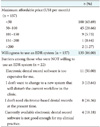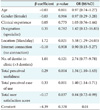1. World Health Organization. Electronic Health Records: a manual for developing countries. Manila: Regional Office for the Western Pacific, World Health Organization;2006.
2. Jathanna VR, Jathanna RV, Jathanna R. The awareness and attitudes of students of one indian dental school toward information technology and its use to improve patient care. Educ Health (Abingdon). 2014; 27(3):293–296.

3. Thit WM, Kaewkungwal J, Soonthornworasiri N, Theera-Ampornpunt N, Kijsanayotin B, Lawpoolsri S, et al. Electronic medical records in Myanmar: user perceptions at Marie Stopes International Clinics in Myanmar. Southeast Asian J Trop Med Public Health. 2016; 47(4):799–809.
4. American Dental Association. Survey of dental practice 2003 special report. Chicago (IL): American Dental Association Survey Center;2006.
5. Layman EJ. Ethical issues and the electronic health record. Health Care Manag (Frederick). 2008; 27(2):165–176.

6. Bernat JL. Ethical and quality pitfalls in electronic health records. Neurology. 2013; 80(11):1057–1061.

7. Kohn LT, Corrigan JM, Donaldson MS. Institute of Medicine. To err is human: building a safer health system. Washington (DC): National Academies Press;2000.
8. Khalifa M. Barriers to health information systems and electronic medical records implementation: a field study of Saudi Arabian hospitals. Procedia Comput Sci. 2013; 21:335–342.

9. Iversen TB, Landmark AD, Tjora A. The peace of paper: patient lists as work tools. Int J Med Inform. 2015; 84(1):69–75.

10. van der Zande MM, Gorter RC, Wismeijer D. Dental practitioners and a digital future: an initial exploration of barriers and incentives to adopting digital technologies. Br Dent J. 2013; 215(11):E21.

12. Tange HJ. The paper-based patient record: is it really so bad? Comput Methods Programs Biomed. 1995; 48(1-2):127–131.

13. Surendran P. Technology acceptance model: a survey of literature. Int J Bus Soc Res. 2012; 2(4):175–178.
14. Holden RJ, Karsh BT. The technology acceptance model: its past and its future in health care. J Biomed Inform. 2010; 43(1):159–172.

15. Gliem JA, Gliem RR. Calculating, interpreting, and reporting Cronbach's alpha reliability coefficient for Likert-type scales. In : Proceedings of Midwest Research-to-Practice Conference in Adult, Continuing, and Community Education; 2003 Oct 8-10; Columbus, OH.
16. Santos JR. Cronbach's alpha: a tool for assessing the reliability of scales. J Ext. 1999; 37(2):1–5.
17. Tavakol M, Dennick R. Making sense of Cronbach's alpha. Int J Med Educ. 2011; 2:53–55.

18. Munyisia EN, Yu P, Hailey D. The changes in caregivers' perceptions about the quality of information and benefits of nursing documentation associated with the introduction of an electronic documentation system in a nursing home. Int J Med Inform. 2011; 80(2):116–126.

19. Powell V, Din FM, Acharya A, Torres-Urquidy MH. Integration of medical and dental care and patient data. London: Springer;2012.
20. Flores-Mir C, Palmer NG, Northcott HC, Khurshed F, Major PW. Perceptions and attitudes of Canadian dentists toward digital and electronic technologies. J Can Dent Assoc. 2006; 72(3):243.
21. Park YT, Han D. Current status of electronic medical record systems in hospitals and clinics in Korea. Healthc Inform Res. 2017; 23(3):189–198.

22. Mostafa AA, Almasari FS, Sadek KW, Alshehri RH, Abduljabbar SM, Alqahtani YS. Evaluation of students’ perception in using electronic dental records. Saudi J Oral Sci. 2015; 2(1):14–18.

23. John JH, Thomas D, Richards D. Questionnaire survey on the use of computerisation in dental practices across the Thames Valley Region. Br Dent J. 2003; 195(10):585–590.

24. Kwak ES, Chang H. Medical representatives’ intention to use information technology in pharmaceutical marketing. Healthc Inform Res. 2016; 22(4):342–350.

25. Schleyer TK, Thyvalikakath TP, Spallek H, Torres-Urquidy MH, Hernandez P, Yuhaniak J. Clinical computing in general dentistry. J Am Med Inform Assoc. 2006; 13(3):344–352.





 PDF
PDF ePub
ePub Citation
Citation Print
Print









 XML Download
XML Download